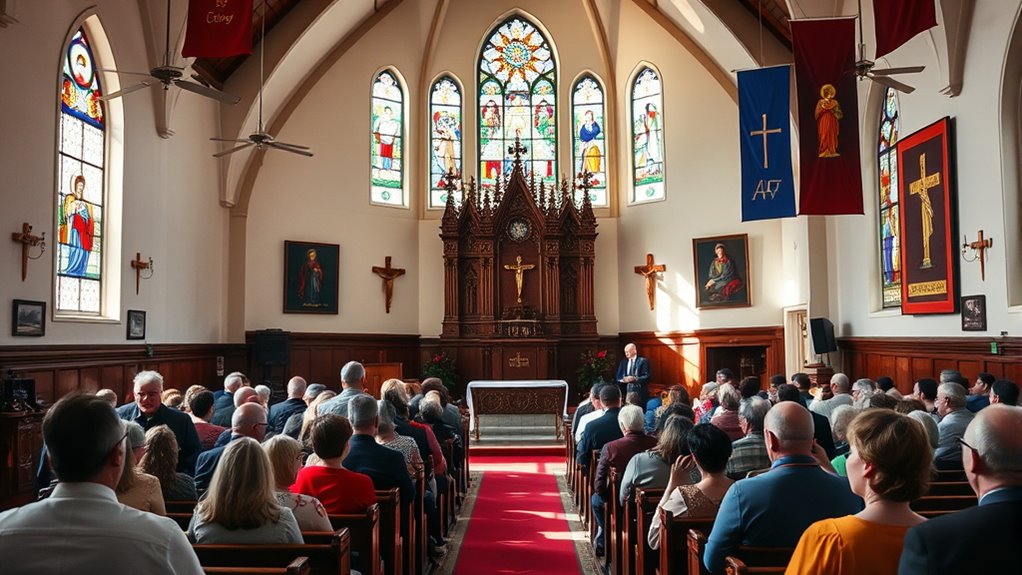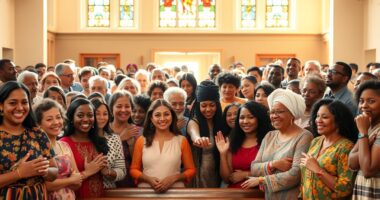Christian denominations are many because of complex history, cultural influences, and theological differences that evolved over centuries. Movements like the Reformation challenged church authority and led to new groups with unique beliefs. Regional customs, traditions, and social factors also shaped diverse worship styles and practices. Today, efforts toward unity coexist with the growth of independent churches and social movements. To understand how all these factors fit together, you’ll find a deeper picture as you explore further.
Key Takeaways
- Historical schisms, regional differences, and cultural influences led to the formation of diverse Christian traditions.
- The Reformation and theological developments prompted new denominations with unique beliefs and practices.
- Variations in biblical interpretation and authority structures create doctrinal diversity among Christian groups.
- Traditions, symbols, and social movements shape community identity and contribute to denominational differences.
- The desire for spiritual autonomy and adaptation to societal changes fostered the growth of independent and non-denominational churches.
Historical Roots of Christian Diversity

The diversity within Christianity today can be traced back to early historical events that shaped its development. As different groups formed, they engaged in ecumenical dialogue to understand one another, often emphasizing shared beliefs while acknowledging differences. This ongoing conversation helped foster unity despite doctrinal variations. Ecumenical dialogue played a significant role in promoting understanding and tolerance among various Christian communities. This theological education also played a crucial role, as leaders and scholars studied scripture and church teachings, leading to diverse interpretations and practices. These early efforts to clarify beliefs and build bridges across communities contributed to the rich tapestry of denominations we see now. Additionally, energetic alignment among community members often influenced how these groups evolved and maintained their distinct identities. Over time, these debates and dialogues, combined with regional and cultural influences, created distinct Christian traditions. The influence of regional differences further contributed to the development of diverse doctrines and practices across the globe. Moreover, the historical schisms that occurred at various points in history significantly solidified the differences among denominations, shaping the landscape of Christianity today. Recognizing the importance of historical context helps explain how these divisions emerged and persisted over centuries. Your understanding of these roots reveals how historical events continue to influence modern Christian diversity.
The Reformation and Its Impact
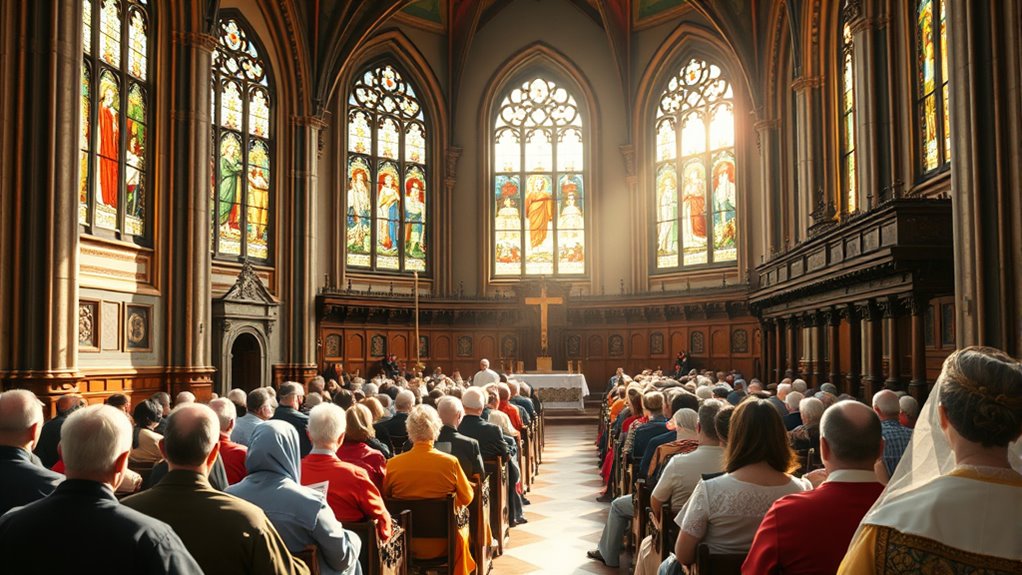
Have you ever wondered how a single movement transformed Christianity forever? The Reformation reshaped church funding and theological education, leading to the rise of new denominations. Before, church funding mainly supported a centralized Catholic Church, but reformers challenged this, advocating for more local control and transparency. They also emphasized the importance of personal study of scripture, which shifted theological education from exclusive clergy training to more accessible learning for laypeople. This movement inspired believers to question authority and interpret the Bible independently, resulting in theological diversity. As a consequence, numerous Protestant denominations emerged, each with distinct beliefs and practices. The Reformation’s focus on individual faith and education forever altered how Christianity functions and how believers participate in their faith communities.
Doctrinal Differences and Interpretations
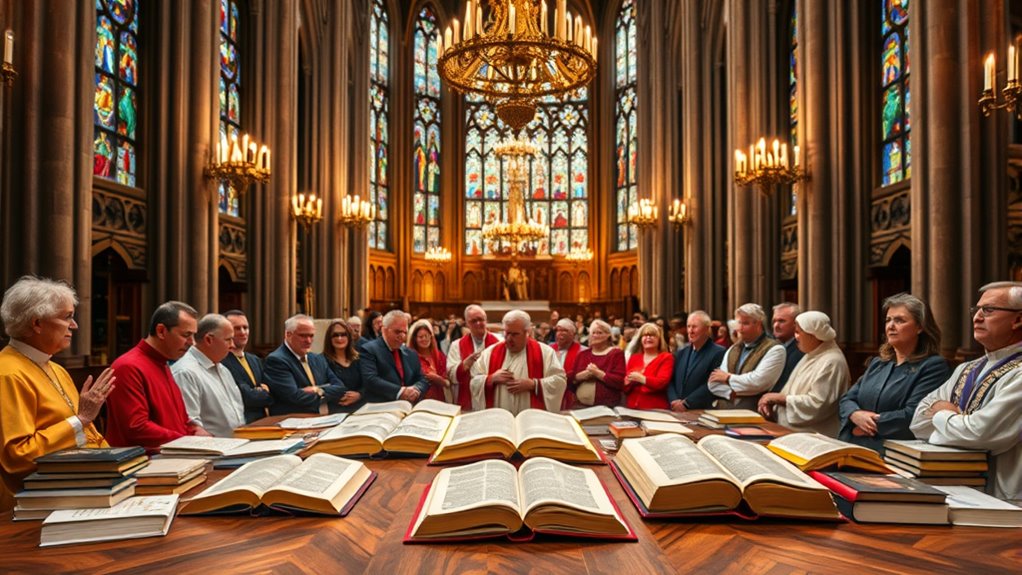
As new denominations emerged from the Reformation, differing beliefs and interpretations of Scripture became a defining feature of Christianity. You’ll find that interpretative flexibility allows each group to understand biblical texts in unique ways, leading to doctrinal debates that shape their identities. These debates often revolve around core issues like salvation, sacraments, and authority, creating distinct doctrines within denominations. Biblical interpretation isn’t always straightforward, and disagreements over scriptural meaning fuel the formation of new churches and divisions. You might notice that even small nuances in interpretation can lead to significant doctrinal differences. This diversity reflects how believers approach Scripture differently, emphasizing personal or communal understanding, which ultimately contributes to the rich tapestry of Christian denominations. Wall organization systems, for example, demonstrate how visual and functional differences can symbolize theological distinctions and community identity.
Cultural and Regional Influences
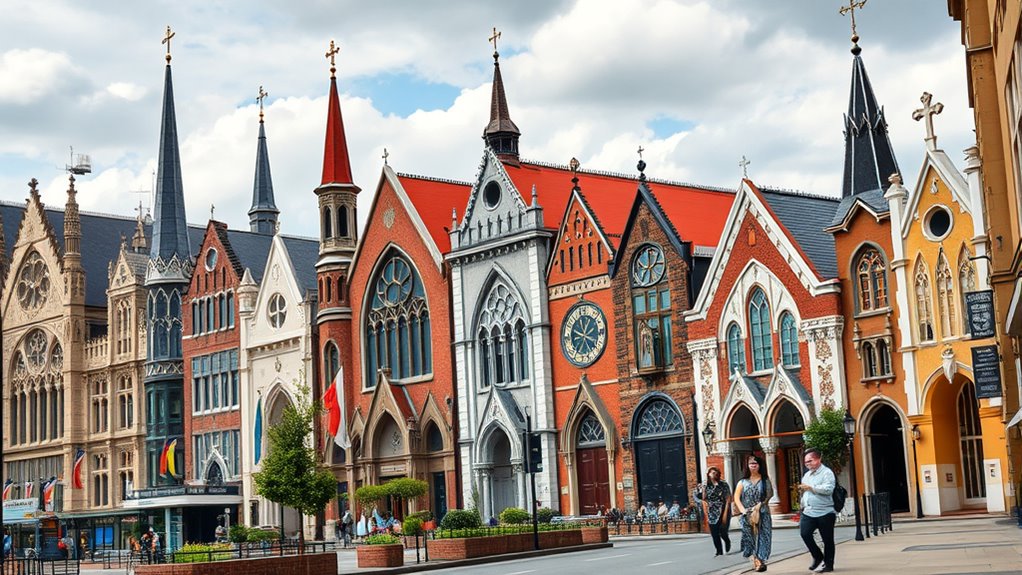
Your faith is often shaped by the culture and region where you practice it. Historical divisions have influenced how different groups interpret and live out their beliefs, creating unique identities. Local traditions and practices add further richness to Christian denominations, reflecting their distinct backgrounds. Additionally, dream symbolism can sometimes influence personal and communal expressions of faith within different regions, as regional religious symbols and practices evolve over time. These variations are also impacted by technological advancements, which facilitate the dissemination of religious ideas and cultural influences across different communities over time. Such technological progress has enabled the sharing of religious texts and teachings, further diversifying practices and beliefs. Furthermore, the spread of honey products and their cultural significance in various regions can serve as metaphors for the diversity seen within Christian practices worldwide.
Historical Divisions Shaping Faith
How did cultural and regional differences influence the development of Christian denominations? These differences shaped distinct practices, especially in liturgical language and hymn traditions. In regions where Latin was spoken, the Catholic Church’s liturgy reflected this language, creating a unified spiritual identity. Conversely, the Eastern Orthodox Church used Greek or local languages, fostering regional ties. Hymn traditions also varied; some cultures emphasized elaborate choral music, while others favored simple melodies. These variations reinforced cultural identities and sometimes led to divisions. Over time, political borders and regional customs deepened these differences, solidifying separate denominations. As a result, faith communities adapted practices that resonated locally, which contributed to the rich diversity within Christianity. These historical divisions continue to influence how denominations worship and express their faith today. Additionally, regional liturgical practices and local customs often became integral to a denomination’s unique identity, further cementing these differences over centuries. Recognizing the impact of cultural and regional influences helps explain the complexity of Christian faith expression worldwide, especially considering how cultural identities are preserved through religious traditions.
Local Traditions and Practices
The diverse historical divisions within Christianity laid the groundwork for the unique local traditions that shape worship today. These traditions reflect local customs and regional festivals, giving each community its distinct expression of faith. You might notice how celebrations vary—from special processions to unique hymns—highlighting regional identities. Such practices often stem from centuries-old history, blending faith with local culture. Recognizing these differences helps you appreciate the richness within Christianity. Here’s a closer look at how local customs influence worship: regional identities
| Tradition Type | Example | Regional Influence |
|---|---|---|
| Local Customs | Unique prayer styles | Cultural heritage |
| Regional Festivals | Feast days, processions | Historical significance |
| Worship Practices | Music, attire, rituals | Climate, geography |
Authority and Church Leadership
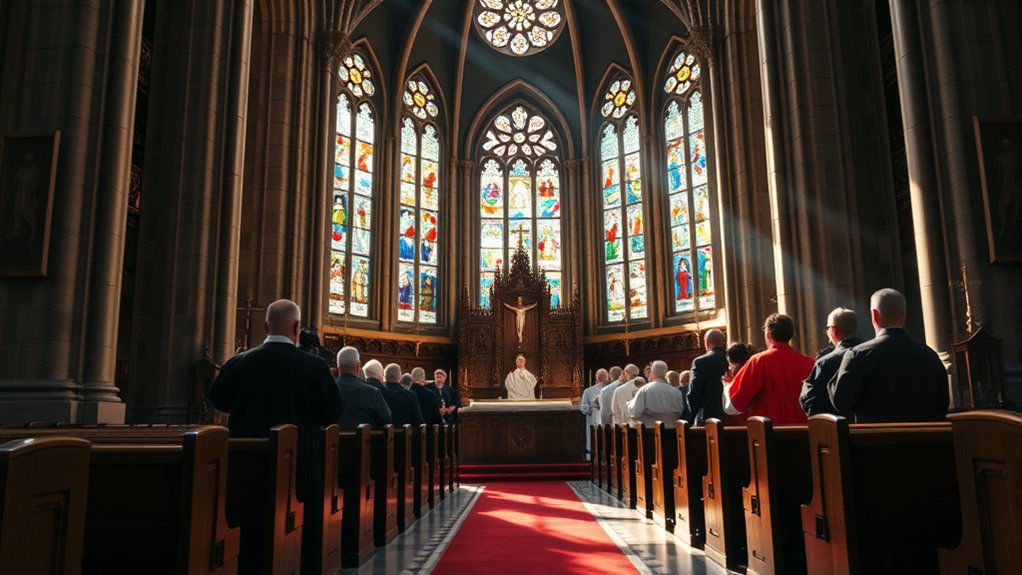
What role does authority play in shaping church leadership across Christian denominations? It determines how decisions are made, who guides spiritual direction, and how hierarchy functions. In many denominations, church governance varies from centralized structures led by bishops or elders to more congregational models where members have a say. Clergy authority also differs; some traditions emphasize the priestly or pastoral role as a divine appointment, while others see leadership as a shared responsibility. These differences influence how leadership is exercised, how authority is delegated, and how accountability is maintained. Understanding these variations helps explain why denominations develop distinct approaches to church governance and leadership styles. Additionally, the range of support hours available in different regions can impact how church organizations provide assistance and guidance to their members. Recognizing the diversity of church structures is crucial to appreciating the complex landscape of Christian leadership. The role of hierarchy significantly impacts the organization and unity within each denomination, affecting how authority is perceived and exercised. Moreover, the historical development of these structures has shaped present-day practices and beliefs. The authority structures often reflect broader cultural and historical influences, contributing to the rich variety seen across Christian groups. Ultimately, authority shapes the spiritual and organizational identity of each Christian group.
Worship Practices and Rituals
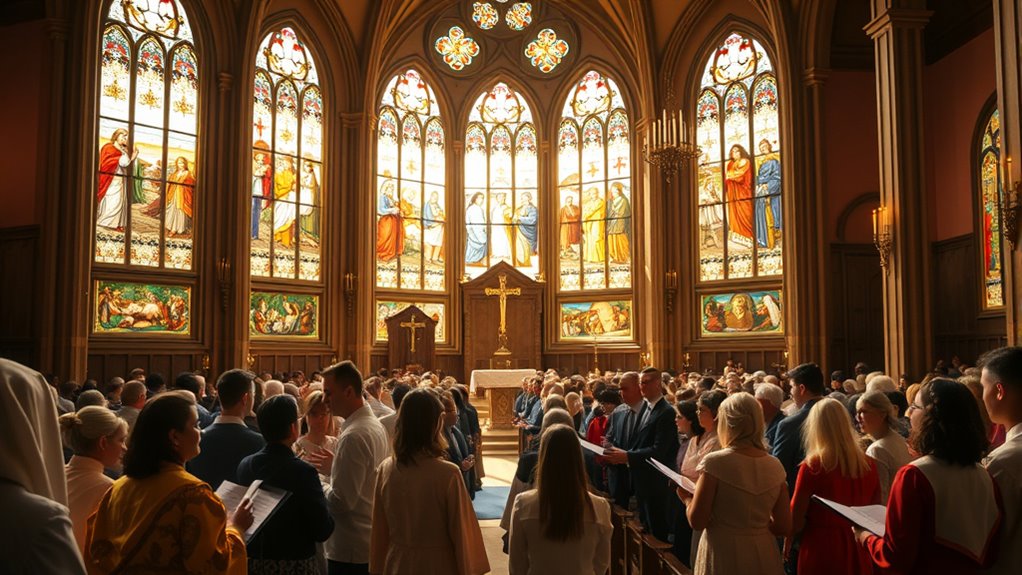
Worship practices and rituals vary widely among Christian denominations, shaping how communities connect with their faith. You’ll notice differences in sacraments and ceremonies that mark important spiritual moments, as well as diverse worship styles that reflect each tradition’s identity. Exploring these variations helps you understand how believers express their devotion in unique ways. Additionally, worship styles can be tailored to reflect cultural influences and theological emphases, further enriching the spiritual experience. Understanding the flushing mechanisms behind various traditions can also shed light on the symbolism and significance of certain rituals. Recognizing the physical changes that occur during different stages of pregnancy can deepen appreciation for the diverse ways faith communities celebrate life and renewal.
Sacraments and Ceremonies
Sacraments and ceremonies serve as essential expressions of faith and community within Christian traditions. These practices often involve liturgical rites that symbolize spiritual truths and reinforce believers’ connection to God. Through sacramental theology, each rite embodies specific beliefs, like baptism representing initiation or the Eucharist commemorating Christ’s sacrifice. Different denominations emphasize various ceremonies, but all see them as crucial to spiritual growth and communal identity. You participate in these rituals to affirm your faith, seek spiritual renewal, and unite with others in worship. The precise form and meaning of sacraments vary, but their purpose remains consistent: to serve as tangible signs of divine grace and to deepen your relationship with God and fellow believers.
Worship Style Variations
Across Christian denominations, worship practices and rituals vary widely, reflecting different theological emphases and cultural influences. You’ll notice that hymn styles range from traditional, choir-led songs to contemporary, guitar-driven praise, shaping the worship atmosphere. Prayer formats also differ—some churches emphasize formal, structured prayers, while others prefer spontaneous, free-form expressions. These variations serve to connect worshipers deeply with their faith and community. You might find liturgical services with scripted rituals or more informal gatherings focused on personal reflection. Despite differences, all aim to foster an authentic encounter with God. Understanding these worship style variations helps you appreciate how each denomination expresses devotion uniquely, enriching your overall perspective on Christian practice.
The Role of Traditions and Creeds
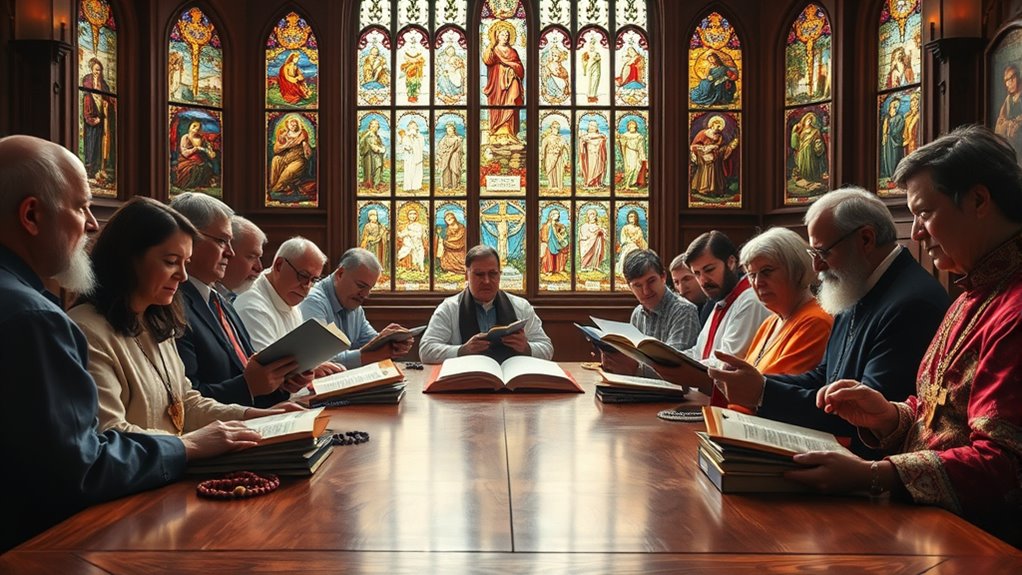
Have you ever wondered how Christian denominations maintain their unique identities? Traditions and creeds play a vital role in this process. They serve as tools for tradition preservation and reinforce creedal significance, ensuring core beliefs stay consistent over time. These shared statements and customs help communities stay connected and distinguish themselves from others.
| Tradition Preservation | Creedal Significance | Community Identity |
|---|---|---|
| Practices passed down | Statements of faith | Shared beliefs |
| Rituals and customs | Doctrinal clarity | Cultural unity |
| Historical roots | Symbolic meaning | Group cohesion |
Social and Political Factors
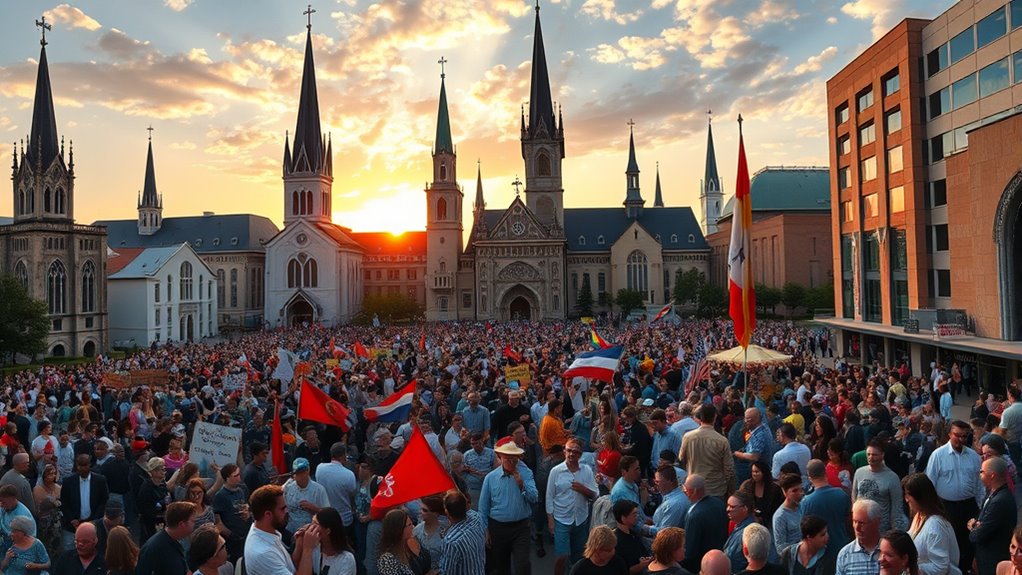
Your understanding of Christian denominations can be shaped by how historical political alignments influenced religious groups. Cultural identity expressions often reflect social and political loyalties that influence beliefs and practices. Additionally, social movements have played a role in shaping denominations’ stances on issues, affecting their development and public perception.
Historical Political Alignments
Understanding how Christian denominations have historically aligned with political powers reveals the complex ways religion and politics intertwine. Throughout history, many denominations formed alliances with ruling authorities to gain influence or protect their followers. These political alignments often shaped doctrines, practices, and church authority. For example, state-sponsored churches reinforced national identity and political stability. This history also influenced modern efforts like ecumenical dialogue and interfaith cooperation, aiming to bridge divides rooted in past political conflicts. Recognizing these historical ties helps you understand why some denominations maintain specific political stances or cultural identities. It also explains the importance of dialogue in fostering unity despite long-standing differences. Overall, these political alignments have deeply impacted how denominations develop and interact on social and global levels.
Cultural Identity Expressions
Cultural identity expressions within Christian denominations are shaped considerably by social and political factors that influence how communities define themselves. These factors often manifest through distinctive church architecture, which reflects local tastes, historical influences, and theological emphasis. For example, grand cathedrals symbolize tradition and authority, while simple meetinghouses emphasize community and humility. Religious symbolism also plays a essential role, serving as visual cues that convey shared beliefs and values. Crosses, icons, and stained glass windows often reflect cultural heritage and political history, reinforcing a community’s identity. These expressions help congregations affirm their distinctiveness within the broader Christian landscape, signaling allegiance to particular doctrinal or cultural ideals. Ultimately, they serve as visual and physical representations of a community’s social and political identity.
Social Movements Influence
Social movements have increasingly shaped how Christian communities express their identities, reflecting broader political and societal trends. You’ll notice how social activism motivates many denominations to advocate for justice, equality, and social change. Faith-based initiatives often emerge from these movements, translating religious beliefs into tangible actions like charity work or policy advocacy. These efforts can lead to the formation of new denominations or divisions within existing ones, as groups align with different causes or approaches. For example, some communities emphasize social justice, while others focus on traditional doctrines. This influence of social movements helps explain why Christian denominations are so diverse today—each responding to the social and political issues that resonate with their members’ values and beliefs.
The Growth of Independent and Non-Denominational Churches

In recent years, independent and non-denominational churches have experienced remarkable growth across many regions. You might notice more of these churches emerging through church planting efforts, which allow communities to establish local worship centers quickly. Many believers are drawn to these churches because they value spiritual independence, preferring a more personalized approach to faith without strict denominational structures. These churches often focus on contemporary worship styles, flexible leadership, and direct engagement with their communities. As a result, they appeal to people seeking a more accessible and less hierarchical form of Christianity. This growth reflects a desire for autonomy in faith practice and a move away from traditional denominational identities, making the landscape of Christianity more diverse and dynamic today.
Ongoing Movements Toward Unity and Ecumenism
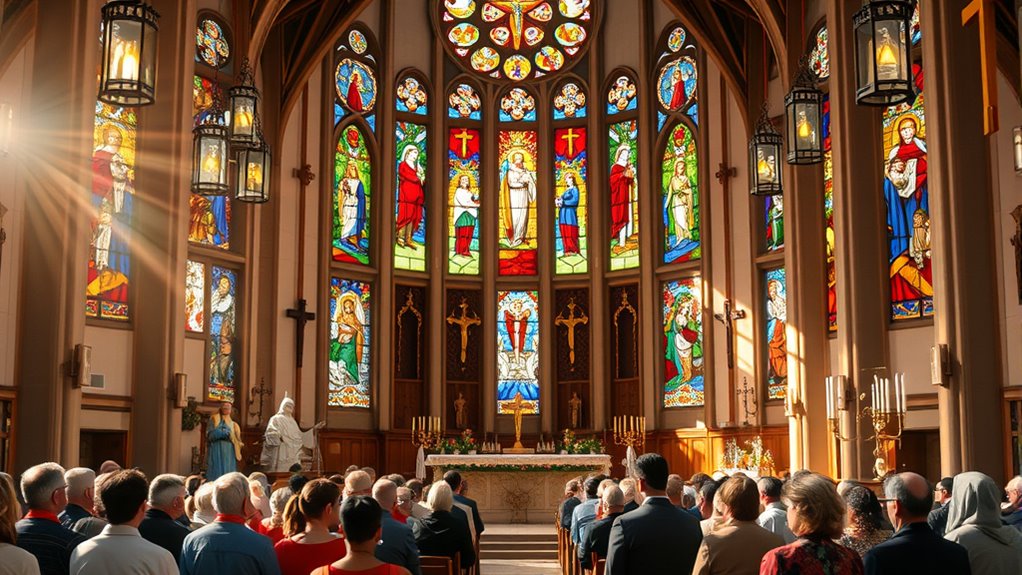
Have you noticed a growing push among different Christian groups to collaborate and find common ground? Movements toward unity and ecumenism aim to bridge denominational divides through interfaith dialogue and theological convergence. These efforts promote understanding, respect, and shared mission, even amid doctrinal differences. Churches participate in joint worship, conferences, and community projects, fostering relationships that transcend traditional boundaries. This movement isn’t about losing individual identity but about working together for common goals like social justice and spiritual growth. Here’s a quick look at some key aspects:
| Focus Area | Goal |
|---|---|
| Interfaith Dialogue | Building mutual understanding |
| Theological Convergence | Finding shared beliefs and values |
| Ecumenical Movements | Promoting unity among Christian groups |
| Shared Missions | Collaborating on social initiatives |
Frequently Asked Questions
How Do Denominations Differ in Their Core Beliefs?
You’ll notice denominations differ in their core beliefs due to theological disagreements and varying interpretations of scripture. These differences influence worship practices, sacraments, and church authority. Some focus heavily on tradition, while others emphasize personal faith. These core distinctions shape how each denomination understands salvation, the role of Jesus, and the church’s mission, leading to diverse practices and beliefs within Christianity.
What Role Does Geography Play in Denomination Development?
You see, geographic influences and regional traditions shape how denominations develop. When communities are isolated or have unique cultural practices, they often form distinct beliefs and worship styles. These regional differences lead to denominations that reflect local customs and interpretations of Christianity. As you travel or learn about various areas, you’ll notice how geography influences religious practices, making each denomination uniquely tied to its local history and cultural identity.
Why Do Some Denominations Emphasize Certain Sacraments More Than Others?
Imagine you’re visiting two churches; one emphasizes baptism as essential for salvation, while the other focuses more on communion’s sacramental significance. These ritual variations reflect differing beliefs about spiritual grace and authority. Some denominations prioritize certain sacraments because they see them as crucial for salvation or community identity, shaping their doctrines and worship styles. Your understanding of these differences reveals how theology influences ritual emphasis across Christian groups.
How Do Denominations Handle Interfaith Relationships and Dialogue?
You might wonder how denominations handle interfaith marriage and dialogue practices. Many denominations promote respectful interfaith relationships by encouraging open dialogue and understanding. They often support couples through counseling and emphasize shared values. Some denominations actively participate in interfaith dialogues to foster mutual respect and cooperation. While practices vary, the goal is generally to promote harmony, acceptance, and peaceful coexistence between different faith traditions.
What Are the Future Trends in Christian Denominational Diversity?
Imagine a river flowing into countless streams, each carving its own path. Future trends in Christian denominational diversity will see more of these streams merging through ecumenical cooperation, fostering unity amid variety. Digital evangelism will act like a beacon, reaching diverse communities worldwide. You’ll witness denominations embracing technology and dialogue, creating a vibrant, interconnected tapestry that reflects both tradition and innovation, shaping a more inclusive, dynamic Christian landscape.
Conclusion
With over 34,000 Christian denominations worldwide, it’s clear why diversity thrives. You see, historical events, cultural influences, and differing doctrines all shape these groups. Despite this variety, many churches are working toward unity through ecumenical efforts. So, as you explore Christian faith, remember that this rich tapestry reflects centuries of faith, debate, and adaptation—showing how dynamic and resilient Christianity truly is.

